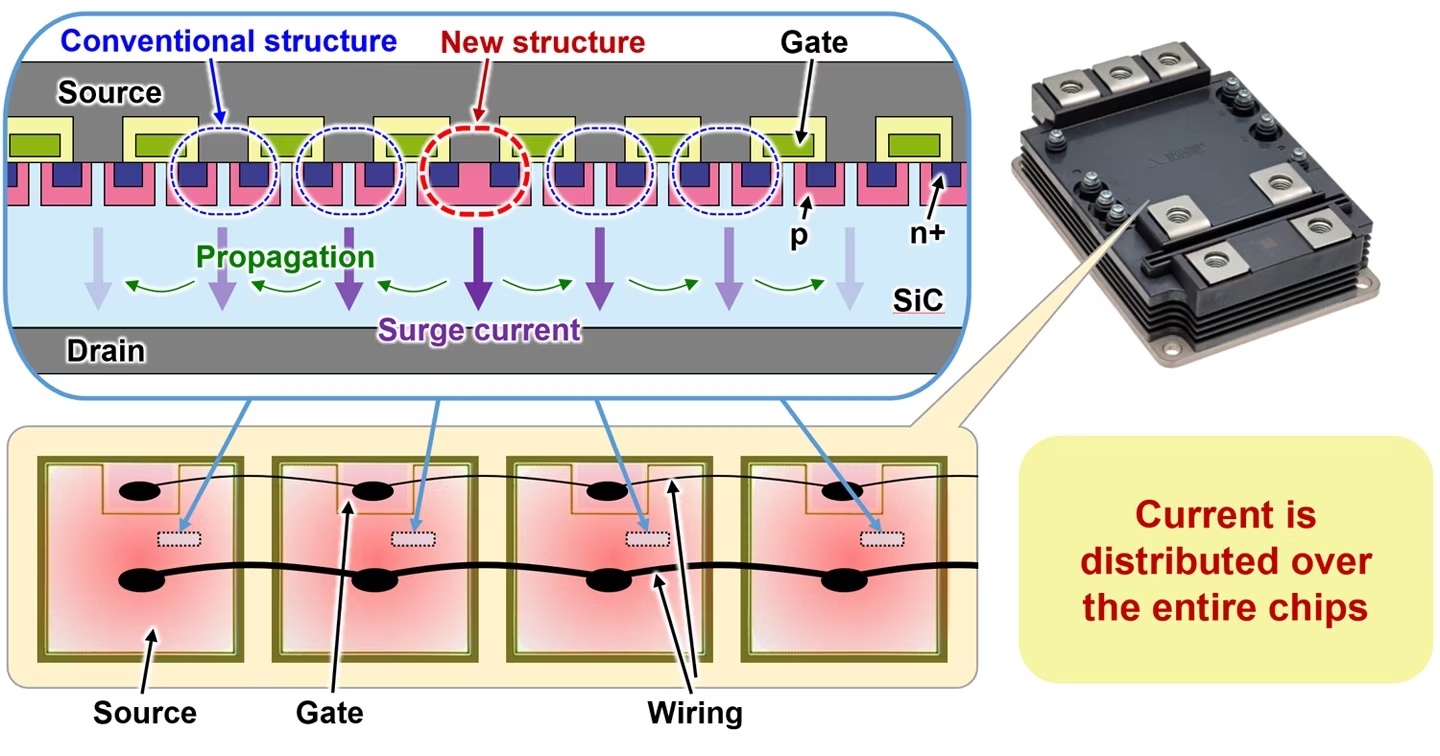News: Microelectronics
8 June 2023
Mitsubishi Electric develops SBD-embedded SiC-MOSFET with new structure for power modules
During the 35th International Symposium on Power Semiconductor Devices and ICs (ISPSD 2023) in Hong Kong (28 May–1 June), Tokyo-based Mitsubishi Electric Corp has developed a new structure for a silicon carbide metal-oxide-semiconductor field-effect transistor (SiC-MOSFET) embedded with a Schottky barrier diode (SBD), which it has applied in the FMF 800 DC-66 BEW 3.3kV full-SiC power module for large industrial equipment such as railways and DC power systems. Samples began shipping on 31 May. The chip’s new structure is expected to help to downsize railway traction systems etc, as well as to make them more energy efficient, and contribute to carbon neutrality through the increased adoption of DC power transmission.

Figure 1: Newly developed chip structure (top: chip section; bottom: parallel-connected chips).
SiC power semiconductors are attracting attention due to their capacity to significantly reduce power loss. Mitsubishi Electric, which commercialized SiC power modules equipped with SiC-MOSFETs and SiC-SBDs in 2010, has adopted SiC power semiconductors for a variety of inverter systems, including air conditioners and railways.
Compared with the conventional method of using separate chips, a chip that integrates a SiC-MOSFET and a SiC-SBD can be mounted in a module more compactly, enabling smaller modules, larger capacity and lower switching loss. It is expected to be widely used in large industrial equipment such as railways and electric power systems. Until now, the practical application of power modules with SBD-embedded SiC-MOSFETs has been difficult due to their relatively low surge-current capability, which results in the thermal destruction of the chips during surge-current events because surge currents in connected circuits concentrate only in specific chips.
Mitsubishi Electric has now developed what it claims is the first mechanism by which surge current concentrates on a specific chip in a parallel-connected chip structure inside a power module, and a new chip structure in which all chips start energizing simultaneously so that surge current is distributed throughout each chip. As a result, the power module’s surge-current capacity has been improved by a factor of five or more compared with the firm’s existing technology, which is equal to or greater than that of conventional silicon power modules, enabling the application of an SBD-embedded SiC-MOSFET in a power module.
SBD-embedded MOSFET
 Figure 2: SBD-embedded SiC-MOSFET integrating a SiC MOSFET and a SiC SBD.
Figure 2: SBD-embedded SiC-MOSFET integrating a SiC MOSFET and a SiC SBD.
In conventional SiC power modules, SiC-MOSFETs are used for switching and SiC-SBDs are used for rectifying, with the two separately manufactured chips being connected in parallel. Conversely, Mitsubishi Electric’s SBD-embedded SiC-MOSFET (Figure 2) integrates the two chips by periodically forming the SiCSBD in the SiC-MOSFET unit cell.
Technology based on confirmation of reason for surge current on single chips
 Figure 3: Conventional current-concentration mechanism on a specific chip.
Figure 3: Conventional current-concentration mechanism on a specific chip.
Conventionally, when surge current flows through multiple SBD-embedded MOSFET chips connected in parallel, the surge current is concentrated only on a specific chip, preventing the surge current withstand capability corresponding to the number of parallel chips from being obtained. Physical and device simulation analyses have now revealed that surge current is concentrated on a specific chip if the dimensions of that chip’s built-in SBD vary even slightly from other chips, which is not uncommon, causing that specific chip to initiate a surge current flow before the other chips (Figure 3). Since the size variation needs only be extremely minor, such variations are basically impossible to avoid in normal chip manufacturing processes.
New chip structure simultaneously energizes all chips connected in parallel
 Figure 4: New structure avoids current concentration on a specific chip.
Figure 4: New structure avoids current concentration on a specific chip.
To prevent surge current from concentrating on specific chips, Mitsubishi Electric has developed a new chip structure in which the built-in SBD is not placed in a unit cell that occupies less than 1% of the total chip area. This unit cell has a structure that allows surge current to flow faster than other unit cells with SBDs, and is unaffected by dimensional variations due to the absence of SBDs. Therefore, surge current can start energizing simultaneously in the corresponding unit cells of all chips without SBDs. In addition, because the surge current reduces resistance of the surrounding SiC, the energizing of the surge current is also triggered in the surrounding unit cells where the surge current is energized, in a chain reaction. This phenomenon causes surge current to propagate throughout the entire chip area, starting from the unit cell where the SBD is not present. Consequently, surge current is distributed over all areas of all chips, preventing thermal breakdown of the chip due to the concentration of surge currents on a particular chip, thereby increasing the surge current withstand capability (Figure 4).
Improved surge current capability enables SBD-embedded SiC-MOSFET power module
 Figure 5: Improved surge-current capability due to new technology.
Figure 5: Improved surge-current capability due to new technology.
Using the new chip structure, the surge current capability of the SBD-embedded SiC-MOSFET in parallel connection has been improved by more than five times compared with the firm’s existing technology, which is equal to or greater than that of widely used conventional silicon power modules.
Furthermore, because of the chain reaction of surge current, a small portion (less than 1%) of the total chip area is sufficient for a unit cell without the built-in SBD, and there is no effect on power module characteristics such as low ON-resistance and low switching loss due to the reduced area of the built-in SBD. As a result, chips can be connected in parallel, a requirement for power modules intended for high-power applications such as railways and electric power systems, thus allowing SBD-embedded SiC-MOSFET to be used in power modules.
Mitsubishi Electric to ship samples of 3.3kV SBD-embedded SiC MOSFET module








